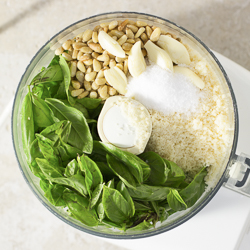Has this ever happened to you? You’re cooking, assembling a casserole, making cookie dough or cake batter, or maybe this Spring Vegetable and Prosciutto Tart, and you realize you forgot to preheat the oven. So you turn it on, but then you’re waiting, the casserole, cookies, cake, or tart ready for baking, and wondering how patient you need to be. In other words, how long does it really take to preheat the oven?
The answer is—it takes a while. Maybe longer than you (or your oven) think.
Here’s how I know this
A few years back, I thought my relatively new oven needed recalibration because it seemed to be cooking unevenly, so I called a repairman. It turned out that the refrigerator needed some attention too, so when he arrived, he put his measuring probes in the oven, cranked it up to 450°F, and turned his attention to the refrigerator.
After 10 or so minutes, as usual, the oven beeped to tell us it was at temp. He ignored it and kept at the fridge. Why? Because his remote thermometer, the one that was attached to the probes in the oven, wasn’t anywhere hear 450°F. Seeing the thermometer for myself, I was, like, what-the-what? And he explained that the oven beeping doesn’t mean squat. That most ovens take at least 20 minutes to get up to temperature, and maybe more. Especially a high temperature like 450°F.
Once it got there, or whatever successive temperature he tested, my oven was fine. Nothing wrong. No recalibration needed. All it I needed was patience.
Now what?
Since then I’ve done a little online research and some sources say 10 to 15 minutes is enough for preheating, while others are more conservative at 20 minutes. But I witnessed that remote temperature gauge with my own eyes and it took a good 30 minutes to reach 450°F. So I almost always preheat for 20 to 30 minutes depending on my cooking temperature, just to be super sure.
(Why don’t I just get one of those thermometers that can sit on the oven rack to gauge whether my oven is properly preheated? Because they seem too cheap to trust my cookies to. I’d rather be patient and let the oven do its thing for a few more minutes.)
Of course, all this may or may not be true of your oven. But if your first batch of cookies turns out much differently than successive batches, or if cakes that are supposed to be set after 20 minutes take more like 25, it could be that your oven, like mine, works perfectly fine—it just isn’t ready for cooking after a 10-minute preheat.
Is preheating critical?
It depends.
Things that need to rise, like cakes and bread, need an initial blast of heat to do that well. Cookies need to set around the edges so that they’ll rise a little instead of spreading a lot. Flaky piecrusts and pastries, like the puff pastry in this Spring Vegetable and Prosciutto Tart, need an initial blast of heat so the fat in the dough melts and steams, creating the air pockets that make flakiness.
But any time you’re essentially just heating something, like a lasagna where everything in the pan is already cooked and you’re just warming and melting it all together, preheating isn’t critical. Nor is it critical for most things that are going to cook for a long time, like a turkey. But if you don’t preheat—or you don’t preheat long enough—it’ll take that much longer until your lasagna or turkey is done.
Bottom line, preheating probably takes longer than you think, but it’s worth having patience for. Because it’s yet another small thing that can make a big difference in your cooking.
Recipes to practice preheating:
Spring Vegetable and Prosciutto Tart
Classic Roast Chicken with Roast Potatoes
Pan-Roasted Salon with Cilantro-Scallion Salsa
Pizza with Salami, Mozzarella, and Fresh Herbs
Strawberry Rosemary Muffins
Salted Cherry Almond Oatmeal Cookies











